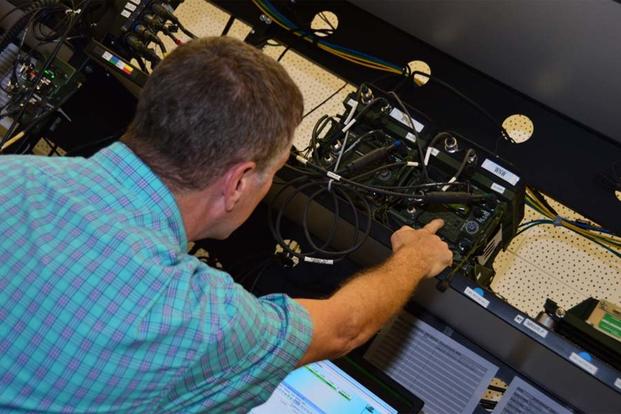The U.S. Army will soon equip units from the 82nd Airborne Division with special radios designed for satellite-denied battlefields, despite a Pentagon memo criticizing the system's performance during recent field tests.
Officials plan to field the Mid-Tier Networking Vehicular Radio, or MNVR, to the 82nd's 1st Brigade Combat Team this fall and to its 3rd BCT in the spring, said Col. James P. Ross, who runs Project Manager Tactical Radios.
To Ross, the radio represents a new capability for commanders because it links company-level communications -- Soldier Radio Waveform -- to battalion- and brigade-level comms -- Wideband Networking Waveform – without the need of satellites.
Since the first Gulf War, satellites have provided combat units with tools such as Blue Force Tracker to help them communicate well beyond the capabilities of conventional terrestrial radios, allowing commanders to spread their formations out over a much wider area, Ross said.
But this reliance on satellites has left combat units vulnerable since potential adversaries, such as Russia, can now deny satellite coverage to large areas, he said.
That's where the MNVR comes in, providing "a huge data throughput at the battalion and brigade level, terrestrially, that wasn't there," Ross said.
"When they try to deny [satellite], this radio capability now provides you the only throughput you are going to have at the terrestrial level," he said.
The Army's plan to field the MNVR comes just months after a blistering memo from Michael Gilmore, the Pentagon's chief weapons tester, chastising the boxy radio for not meeting commanders' operational needs for a mid-tier network solution.
Gilmore's July 5 memo was based on an assessment conducted by the Brigade Modernization Command during the Army's Network Integration Evaluation 16.2 at Fort Bliss, Texas, in May.
All 39 of the surveyed battalion and company commanders and senior staff recommended that the Army not field the MNVR, Gilmore said in the memo, according to news reports.
The memo also said that the MNVR provided no added value in mitigating the significant impacts to communications and mission execution experienced in a satellite communications-denied environment.
Army tactical radio officials disagreed with Gilmore's findings because the MNVR did exactly what it was supposed to do.
"We did do this exercise back in May where we took the unit down, shut down their satellite, turned [Blue Force Tracker ] off. It's the first time an American unit in about 25 years did not have reliance on a satellite," Ross said, adding that the test unit likely did not anticipate the challenges of operating without a satellite connection.
"It worked, but it did cause some consternation within the unit in terms of 'OK, I've got to now plan my network.' "
Gilmore criticized the MNVR's range since brigade- and battalion-level signal staff were forced to develop communications plans that conflicted with the units' maneuver plans in order to compensate for the MNVR's limited transmission range.
Army radio officials acknowledged that the MNVR still depends on line-of-sight, so commanders have to do more planning for where to position re-transmission sites to get extra range, Ross said.
"It's still line-of-sight, so if you want to get greater distance, you have to put a re-trans site out, so you got to put protection around it. … There is planning that goes into that, which again, your network is part of your fighting force," he said.
The Army plans to field about 120 MNVRs per brigade, which will go into vehicles and tactical operations centers.
The service is studying the best way for units to employ the MNVR, Army radio officials said.
Feedback from 1st and 3rd BCT will be used to refine the doctrine for how soldiers use the MNVR in a satellite-denied area.
The service plans to field four BCTs over the next two years and "then take a look at the strategy for the Army for a single vehicular radio strategy," Ross said.
The head of the Army's radio program acknowledged the criticism that the MNVR is boxy and may be too large for some vehicles, such as the M1 Abrams tank and the M2 Bradley Fighting Vehicle since "there is so little space in these things."
The next version of the MNVR will be smaller, he said.
Radio officials said they are using the MNVR to lay down an "eight-lane highway" for data. "Right now, we are probably using about two or three lanes of it," Ross said.
"Also, it's allowing for the ability to say, 'Well, now we have a robust terrestrial network, so we don't just only have to rely on [satellite].' "
-- Matthew Cox can be reached at matthew.cox@military.com.






























